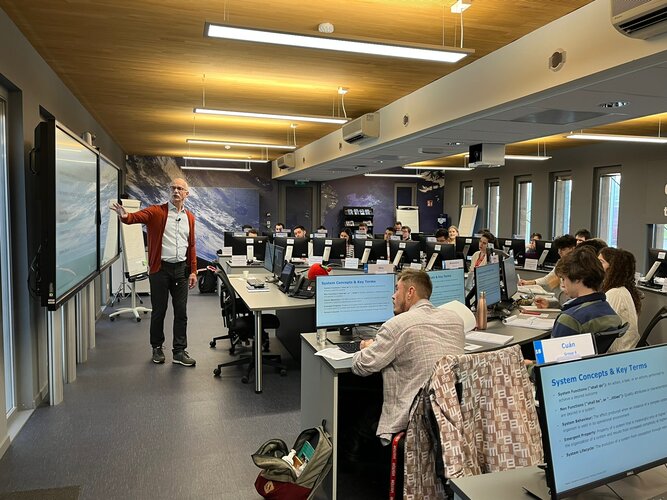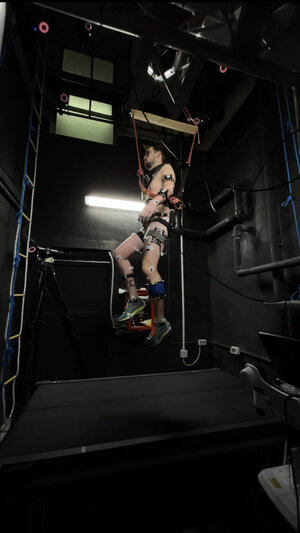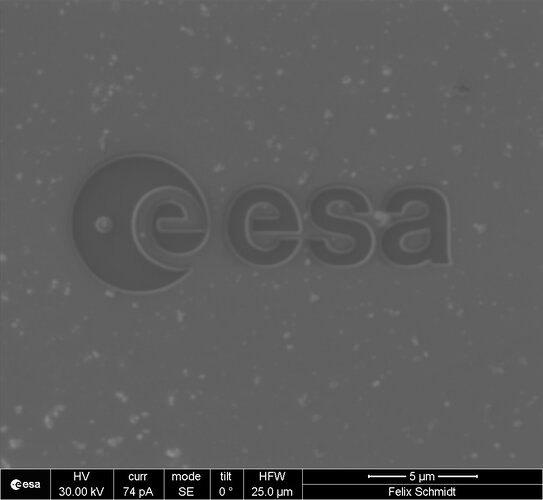
Copernical Team
Friday, 24 March 2023 20:24
SpaceX launches its 20th mission of the year with launch of 56 Starlink satellites
Space Coast FL (SPX) Mar 24, 2023
 SpaceX launched its 20th mission of 2023 on Friday (March 24), launching 56 of its Starlink internet satellites into low Earth orbit (LEO) and landing the first stage booster on a droneship offshore.
The mission, named Starlink Group 5-5, lifted off at 11:43 AM EDT (15:43 UTC) from Space Launch Complex 40 (SLC-40) from Florida's Cape Canaveral Space Force Station.
About eight and a h
SpaceX launched its 20th mission of 2023 on Friday (March 24), launching 56 of its Starlink internet satellites into low Earth orbit (LEO) and landing the first stage booster on a droneship offshore.
The mission, named Starlink Group 5-5, lifted off at 11:43 AM EDT (15:43 UTC) from Space Launch Complex 40 (SLC-40) from Florida's Cape Canaveral Space Force Station.
About eight and a h
 SpaceX launched its 20th mission of 2023 on Friday (March 24), launching 56 of its Starlink internet satellites into low Earth orbit (LEO) and landing the first stage booster on a droneship offshore.
The mission, named Starlink Group 5-5, lifted off at 11:43 AM EDT (15:43 UTC) from Space Launch Complex 40 (SLC-40) from Florida's Cape Canaveral Space Force Station.
About eight and a h
SpaceX launched its 20th mission of 2023 on Friday (March 24), launching 56 of its Starlink internet satellites into low Earth orbit (LEO) and landing the first stage booster on a droneship offshore.
The mission, named Starlink Group 5-5, lifted off at 11:43 AM EDT (15:43 UTC) from Space Launch Complex 40 (SLC-40) from Florida's Cape Canaveral Space Force Station.
About eight and a h
Published in
News
Tagged under
Friday, 24 March 2023 14:13
First ever ESA Academy Navigation Training Course!

For the first time ever, ESA Academy is opening a call for university students to apply for the pilot edition of the Navigation Training Course, to be held from 26 to 30 June 2023 at ESA Academy’s Training and Learning Facility in ESEC-Galaxia, Belgium. This Training Course has been developed by ESA Education and ESA’s Directorate of Navigation. Would you like to know more about the future of satellite navigation? Apply for our course today!
Published in
News
Tagged under
Friday, 24 March 2023 13:43
Week in images: 20-24 March 2023

Week in images: 20-24 March 2023
Discover our week through the lens
Published in
News
Tagged under
Wednesday, 22 March 2023 15:06
Lunar bounce
 Image:
A participant of the Movement in Low gravity environments (MoLo) programme from ESA’s space medicine team at the European Astronaut Centre in Cologne, Germany, testing movements in simulated reduced gravity, called hypogravity, on Earth.
Image:
A participant of the Movement in Low gravity environments (MoLo) programme from ESA’s space medicine team at the European Astronaut Centre in Cologne, Germany, testing movements in simulated reduced gravity, called hypogravity, on Earth.
Published in
News
Tagged under
Friday, 24 March 2023 09:32
First detection of neutrinos made at a particle collider
Bern, Switzerland (SPX) Mar 20, 2023
 A team including physicists of the University of Bern has for the first time detected subatomic particles called neutrinos created by a particle collider, namely at CERN's Large Hadron Collider (LHC). The discovery promises to deepen scientists' understanding of the nature of neutrinos, which are among the most abundant particles in the universe and key to the solution of the question why there
A team including physicists of the University of Bern has for the first time detected subatomic particles called neutrinos created by a particle collider, namely at CERN's Large Hadron Collider (LHC). The discovery promises to deepen scientists' understanding of the nature of neutrinos, which are among the most abundant particles in the universe and key to the solution of the question why there
 A team including physicists of the University of Bern has for the first time detected subatomic particles called neutrinos created by a particle collider, namely at CERN's Large Hadron Collider (LHC). The discovery promises to deepen scientists' understanding of the nature of neutrinos, which are among the most abundant particles in the universe and key to the solution of the question why there
A team including physicists of the University of Bern has for the first time detected subatomic particles called neutrinos created by a particle collider, namely at CERN's Large Hadron Collider (LHC). The discovery promises to deepen scientists' understanding of the nature of neutrinos, which are among the most abundant particles in the universe and key to the solution of the question why there
Published in
News
Tagged under
Friday, 24 March 2023 09:32
Ultrafast beam-steering breakthrough at Sandia Labs
Albuquerque NM (SPX) Mar 21, 2023
 In a major breakthrough in the fields of nanophotonics and ultrafast optics, a Sandia National Laboratories research team has demonstrated the ability to dynamically steer light pulses from conventional, so-called incoherent light sources.
This ability to control light using a semiconductor device could allow low-power, relatively inexpensive sources like LEDs or flashlight bulbs to replac
In a major breakthrough in the fields of nanophotonics and ultrafast optics, a Sandia National Laboratories research team has demonstrated the ability to dynamically steer light pulses from conventional, so-called incoherent light sources.
This ability to control light using a semiconductor device could allow low-power, relatively inexpensive sources like LEDs or flashlight bulbs to replac
 In a major breakthrough in the fields of nanophotonics and ultrafast optics, a Sandia National Laboratories research team has demonstrated the ability to dynamically steer light pulses from conventional, so-called incoherent light sources.
This ability to control light using a semiconductor device could allow low-power, relatively inexpensive sources like LEDs or flashlight bulbs to replac
In a major breakthrough in the fields of nanophotonics and ultrafast optics, a Sandia National Laboratories research team has demonstrated the ability to dynamically steer light pulses from conventional, so-called incoherent light sources.
This ability to control light using a semiconductor device could allow low-power, relatively inexpensive sources like LEDs or flashlight bulbs to replac
Published in
News
Tagged under
Friday, 24 March 2023 09:32
TDGA secures New Media Holding as lead investor in $20M seed round for Space Media
New York NY (SPX) Mar 24, 2023
 London based TDGA, the owner of the biggest brand in Space Media today, Space Hero, announced a $20m Seed Round. As part of the round, Singapore based New Media Holding, owner of the World's largest Creator network and Asia's largest media network, has invested $5m as a strategic investment. Furthermore, NMH has committed to be the lead investor for this round after an extensive due diligence va
London based TDGA, the owner of the biggest brand in Space Media today, Space Hero, announced a $20m Seed Round. As part of the round, Singapore based New Media Holding, owner of the World's largest Creator network and Asia's largest media network, has invested $5m as a strategic investment. Furthermore, NMH has committed to be the lead investor for this round after an extensive due diligence va
 London based TDGA, the owner of the biggest brand in Space Media today, Space Hero, announced a $20m Seed Round. As part of the round, Singapore based New Media Holding, owner of the World's largest Creator network and Asia's largest media network, has invested $5m as a strategic investment. Furthermore, NMH has committed to be the lead investor for this round after an extensive due diligence va
London based TDGA, the owner of the biggest brand in Space Media today, Space Hero, announced a $20m Seed Round. As part of the round, Singapore based New Media Holding, owner of the World's largest Creator network and Asia's largest media network, has invested $5m as a strategic investment. Furthermore, NMH has committed to be the lead investor for this round after an extensive due diligence va
Published in
News
Tagged under
Friday, 24 March 2023 09:32
Neuraspace introduces "Machine Learning Prediction Plots" for earlier debris planning
Washington (SPX) Mar 24, 2023
 Neuraspace, a European-born global leader in space traffic management (STM), has introduced "Machine Learning Prediction Plots", giving satellite and satellite constellation operators a tool for earlier collision avoidance planning.
As a first in the space industry, the latest addition to Neuraspace's STM software, using artificial intelligence (AI), enables operators to decide several day
Neuraspace, a European-born global leader in space traffic management (STM), has introduced "Machine Learning Prediction Plots", giving satellite and satellite constellation operators a tool for earlier collision avoidance planning.
As a first in the space industry, the latest addition to Neuraspace's STM software, using artificial intelligence (AI), enables operators to decide several day
 Neuraspace, a European-born global leader in space traffic management (STM), has introduced "Machine Learning Prediction Plots", giving satellite and satellite constellation operators a tool for earlier collision avoidance planning.
As a first in the space industry, the latest addition to Neuraspace's STM software, using artificial intelligence (AI), enables operators to decide several day
Neuraspace, a European-born global leader in space traffic management (STM), has introduced "Machine Learning Prediction Plots", giving satellite and satellite constellation operators a tool for earlier collision avoidance planning.
As a first in the space industry, the latest addition to Neuraspace's STM software, using artificial intelligence (AI), enables operators to decide several day
Published in
News
Tagged under
Friday, 24 March 2023 09:32
Sierra Space advances to the forefront of commercial and national security policy in the Orbital Age
Louisville CO (SPX) Mar 21, 2023
 Sierra Space, a leading, pureplay commercial space company building the first end-to-end business and technology platform in space, has announced the creation of a new strategy and government affairs group that positions the company for long-term success and growth in the Orbital Age.
To lead this dynamic new organization, Sierra Space recruited one of Washington, D.C.'s most prominent and
Sierra Space, a leading, pureplay commercial space company building the first end-to-end business and technology platform in space, has announced the creation of a new strategy and government affairs group that positions the company for long-term success and growth in the Orbital Age.
To lead this dynamic new organization, Sierra Space recruited one of Washington, D.C.'s most prominent and
 Sierra Space, a leading, pureplay commercial space company building the first end-to-end business and technology platform in space, has announced the creation of a new strategy and government affairs group that positions the company for long-term success and growth in the Orbital Age.
To lead this dynamic new organization, Sierra Space recruited one of Washington, D.C.'s most prominent and
Sierra Space, a leading, pureplay commercial space company building the first end-to-end business and technology platform in space, has announced the creation of a new strategy and government affairs group that positions the company for long-term success and growth in the Orbital Age.
To lead this dynamic new organization, Sierra Space recruited one of Washington, D.C.'s most prominent and
Published in
News
Tagged under

 Image:
ESA in miniature
Image:
ESA in miniature